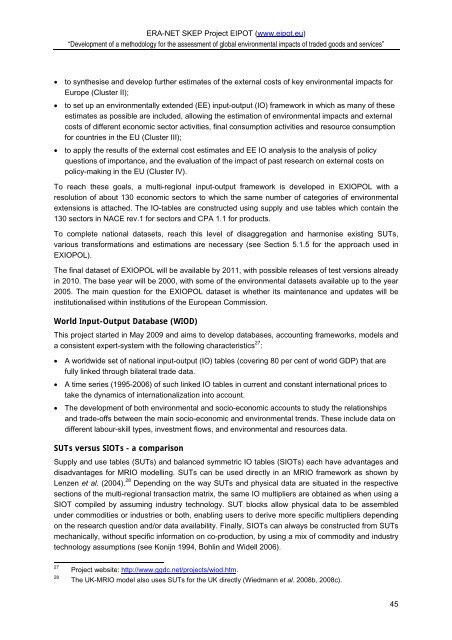EIPOT Final Project Report - Stockholm Environment Institute
EIPOT Final Project Report - Stockholm Environment Institute
EIPOT Final Project Report - Stockholm Environment Institute
Create successful ePaper yourself
Turn your PDF publications into a flip-book with our unique Google optimized e-Paper software.
ERA-NET SKEP <strong>Project</strong> <strong>EIPOT</strong> (www.eipot.eu)<br />
“Development of a methodology for the assessment of global environmental impacts of traded goods and services”<br />
• to synthesise and develop further estimates of the external costs of key environmental impacts for<br />
Europe (Cluster II);<br />
• to set up an environmentally extended (EE) input-output (IO) framework in which as many of these<br />
estimates as possible are included, allowing the estimation of environmental impacts and external<br />
costs of different economic sector activities, final consumption activities and resource consumption<br />
for countries in the EU (Cluster III);<br />
• to apply the results of the external cost estimates and EE IO analysis to the analysis of policy<br />
questions of importance, and the evaluation of the impact of past research on external costs on<br />
policy-making in the EU (Cluster IV).<br />
To reach these goals, a multi-regional input-output framework is developed in EXIOPOL with a<br />
resolution of about 130 economic sectors to which the same number of categories of environmental<br />
extensions is attached. The IO-tables are constructed using supply and use tables which contain the<br />
130 sectors in NACE rev.1 for sectors and CPA 1.1 for products.<br />
To complete national datasets, reach this level of disaggregation and harmonise existing SUTs,<br />
various transformations and estimations are necessary (see Section 5.1.5 for the approach used in<br />
EXIOPOL).<br />
The final dataset of EXIOPOL will be available by 2011, with possible releases of test versions already<br />
in 2010. The base year will be 2000, with some of the environmental datasets available up to the year<br />
2005. The main question for the EXIOPOL dataset is whether its maintenance and updates will be<br />
institutionalised within institutions of the European Commission.<br />
World Input-Output Database (WIOD)<br />
This project started in May 2009 and aims to develop databases, accounting frameworks, models and<br />
a consistent expert-system with the following characteristics 27 :<br />
• A worldwide set of national input-output (IO) tables (covering 80 per cent of world GDP) that are<br />
fully linked through bilateral trade data.<br />
• A time series (1995-2006) of such linked IO tables in current and constant international prices to<br />
take the dynamics of internationalization into account.<br />
• The development of both environmental and socio-economic accounts to study the relationships<br />
and trade-offs between the main socio-economic and environmental trends. These include data on<br />
different labour-skill types, investment flows, and environmental and resources data.<br />
SUTs versus SIOTs - a comparison<br />
Supply and use tables (SUTs) and balanced symmetric IO tables (SIOTs) each have advantages and<br />
disadvantages for MRIO modelling. SUTs can be used directly in an MRIO framework as shown by<br />
Lenzen et al. (2004). 28 Depending on the way SUTs and physical data are situated in the respective<br />
sections of the multi-regional transaction matrix, the same IO multipliers are obtained as when using a<br />
SIOT compiled by assuming industry technology. SUT blocks allow physical data to be assembled<br />
under commodities or industries or both, enabling users to derive more specific multipliers depending<br />
on the research question and/or data availability. <strong>Final</strong>ly, SIOTs can always be constructed from SUTs<br />
mechanically, without specific information on co-production, by using a mix of commodity and industry<br />
technology assumptions (see Konijn 1994, Bohlin and Widell 2006).<br />
27<br />
28<br />
<strong>Project</strong> website: http://www.ggdc.net/projects/wiod.htm.<br />
The UK-MRIO model also uses SUTs for the UK directly (Wiedmann et al. 2008b, 2008c).<br />
45
















